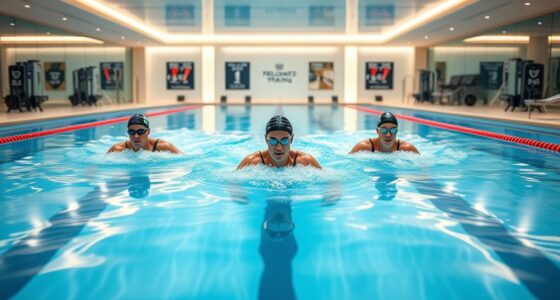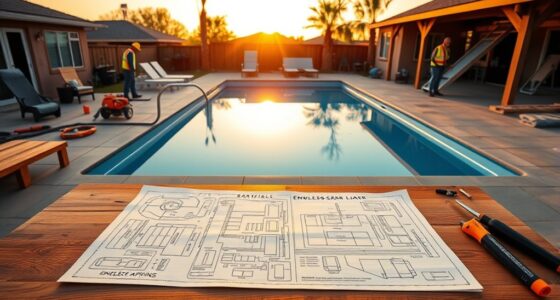Yes, you can install an endless pool indoors, but you’ll need to plan carefully. Make sure you have enough space with high ceilings, sturdy flooring, and proper doorways for installation and maintenance. Focus on a good ventilation system with humidistat-controlled exhaust fans or dehumidifiers to manage moisture. Use non-slip flooring and ample lighting for safety and comfort. Want to learn more about creating the perfect indoor pool setup? Keep exploring for essential tips and ideas.
Key Takeaways
- Ensure the room has adequate ceiling height and structural support to handle the water and equipment weight.
- Install proper ventilation systems with dehumidifiers and exhaust fans to control moisture and prevent mold.
- Use non-slip flooring, proper lighting, and safety features for a comfortable and secure indoor pool environment.
- Seal windows and doors to prevent outside humidity intrusion and maintain consistent indoor moisture levels.
- Regularly maintain filtration, ventilation, and moisture control systems to ensure long-term safety and performance.
Assessing Space and Structural Requirements
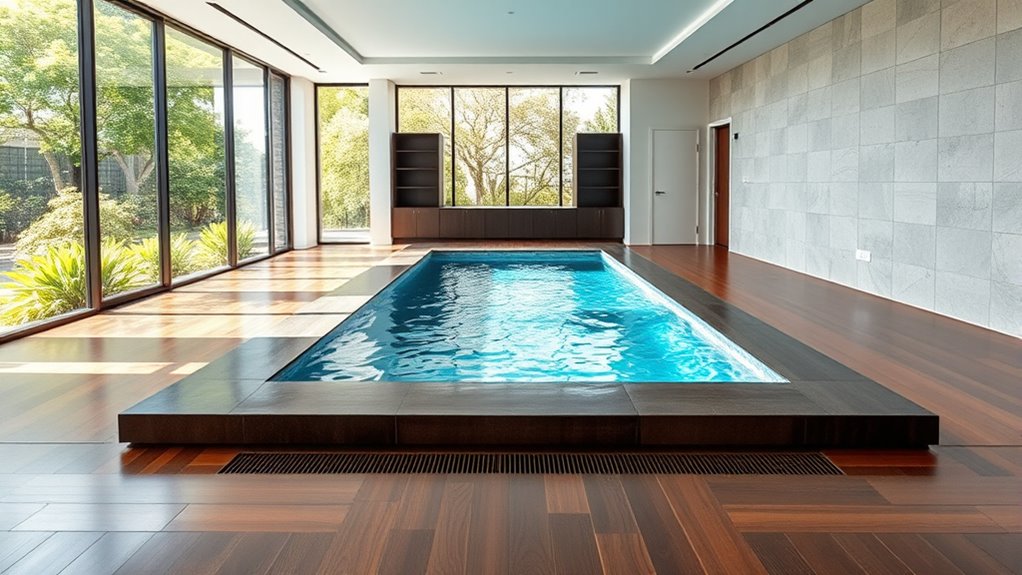
Have you considered whether your space can support an indoor endless pool? Before anything else, measure the area carefully. You need enough room for the pool itself and space to move around comfortably. Check your ceiling height—most pools require a minimum of 8 feet, but taller ceilings are better for ventilation and comfort. Evaluate your existing structure’s load-bearing capacity; a pool adds significant weight, especially when filled with water. You might need to reinforce floors or walls to handle the extra load. Also, consider doorways and pathways for easy installation and maintenance access. Ensuring your space meets these structural and spatial requirements prevents costly modifications later and guarantees safe, effective use of your indoor endless pool. Incorporating attention in planning can help you anticipate potential challenges and optimize your space for creative solutions.
Ensuring Proper Ventilation Systems
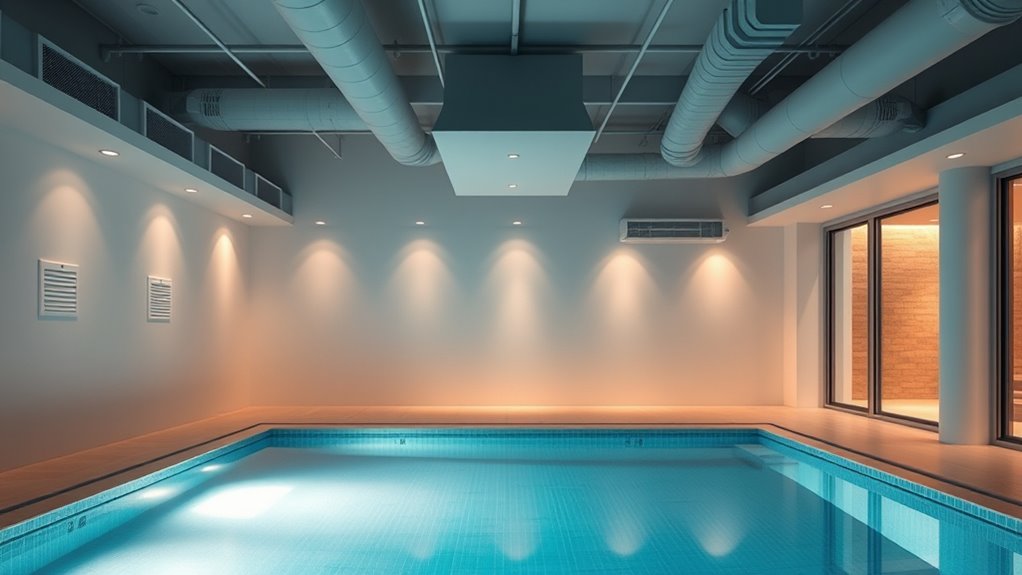
Once you’ve confirmed your space can handle the pool’s size and weight, it’s time to focus on proper ventilation. You need an effective system that exchanges stale air for fresh air regularly. Install a ventilation system designed for humid environments, such as an exhaust fan paired with an intake vent, to ensure continuous airflow. Consider an HVAC setup with dehumidification capabilities to control moisture and prevent mold growth. Make sure vents are strategically placed—near the ceiling to remove rising warm, humid air and near the floor for fresh air intake. Regular maintenance, including filter cleaning and system checks, keeps the ventilation running efficiently. Proper ventilation protects your indoor environment, preserves your space, and keeps you comfortable while enjoying your endless pool.
Managing Moisture and Humidity Levels
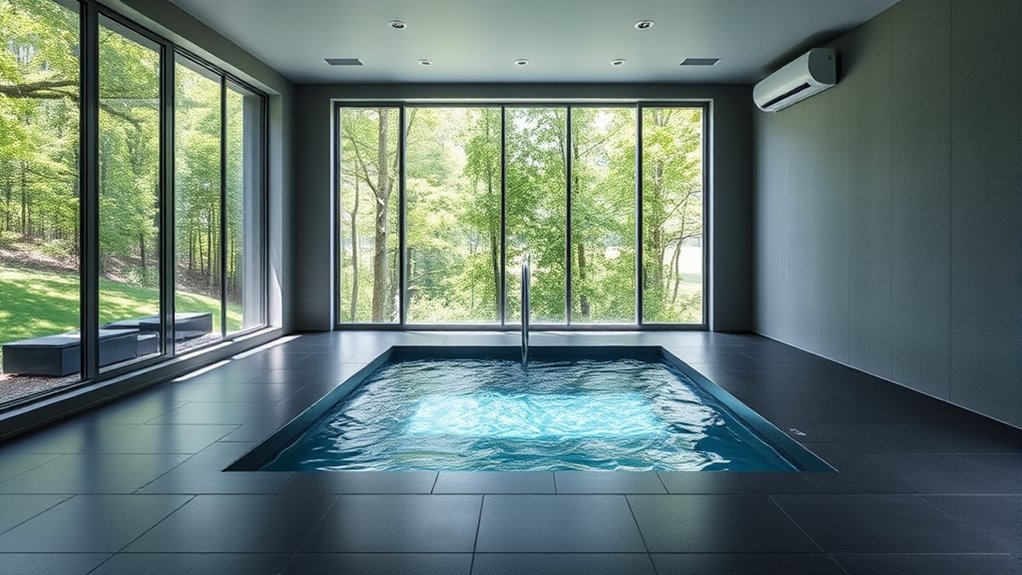
To keep your indoor pool comfortable and safe, managing moisture and humidity levels is essential. High humidity can lead to mold, mildew, and structural damage, so it’s important to keep moisture in check. Use a dehumidifier designed for indoor pools to maintain ideal humidity—preferably between 50-60%. Ensure your ventilation system effectively removes moist air and replaces it with dry, fresh air. Regularly monitor humidity levels with a hygrometer to catch any fluctuations early. Keep pool covers on when not in use to reduce evaporation and moisture release. Properly sealing windows and doors prevents outside humidity from entering. Installing ventilation systems that are specifically designed for indoor pools can significantly improve air quality and humidity control. Staying proactive with these steps helps prevent issues and creates a healthier, more comfortable environment for you and your family.
Designing for Safety and Comfort
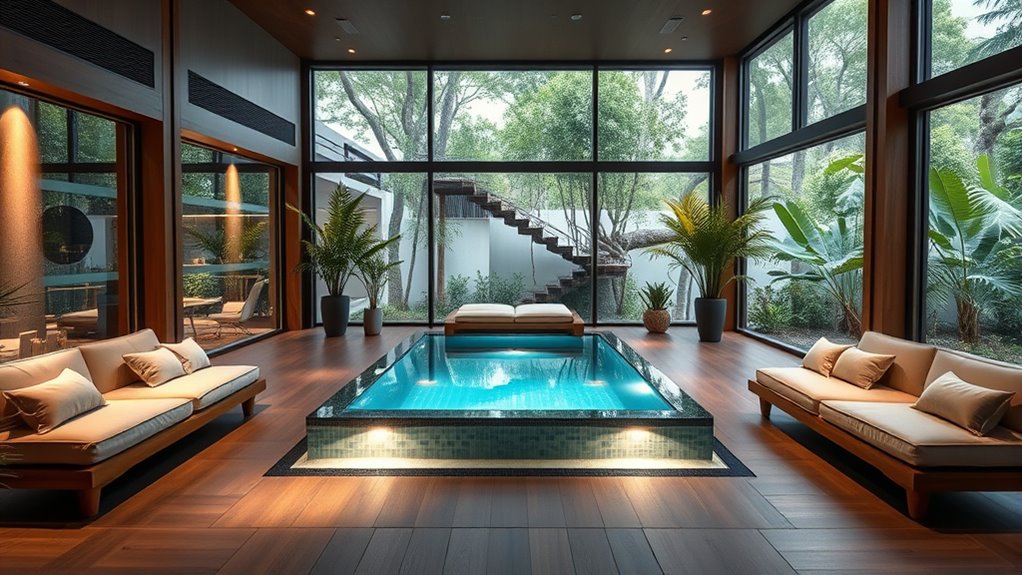
Creating a safe and comfortable indoor pool environment involves careful design choices that prioritize both functionality and user well-being. Start by ensuring adequate space around the pool for safe entry and exit, avoiding tight or cramped areas. Incorporate non-slip flooring to prevent accidents, especially when surfaces are wet. Proper lighting is essential; use bright, even illumination to reduce shadows and enhance visibility. Ventilation should be optimized to control humidity and prevent mold, creating a healthier atmosphere. Consider adding safety features like pool covers, alarms, and handrails for extra security. Comfort also depends on climate control; maintain a consistent temperature and humidity level. Additionally, implementing adequate ventilation systems is crucial to manage moisture levels effectively. Thoughtful design guarantees your indoor pool remains a safe, inviting space that you can enjoy comfortably year-round.
Maintenance and Long-Term Considerations
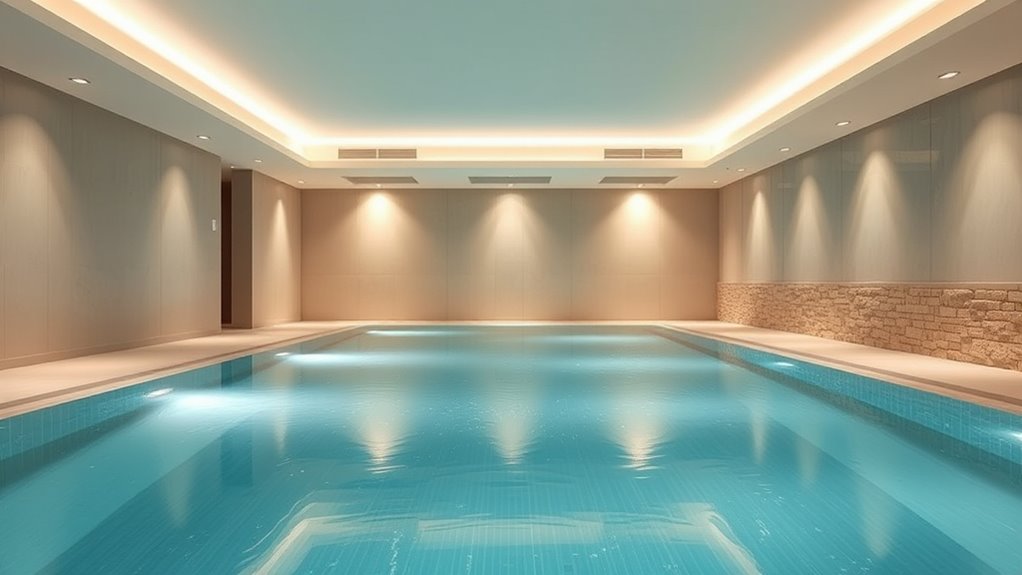
Maintaining an indoor pool requires ongoing attention to equipment, water quality, and cleanliness to keep it safe and inviting. Regularly check your filtration system and replace filters as needed to ensure proper circulation and clarity. Test your water chemistry weekly—balance pH, alkalinity, and sanitizer levels to prevent bacteria growth and corrosion. Keep the pool area clean by sweeping and wiping down surfaces, and ensure good ventilation to manage humidity and prevent mold. Schedule annual inspections of pumps, heaters, and other equipment to catch issues early. Consider investing in a dehumidifier or ventilation system to control moisture over time. Be aware that detecting passive voice can improve the clarity and effectiveness of your maintenance communication. Consistent upkeep minimizes costly repairs, prolongs equipment lifespan, and creates a healthier, more enjoyable swimming environment for years to come.
Frequently Asked Questions
What Are the Electrical Requirements for Indoor Endless Pools?
You need a dedicated, properly grounded electrical circuit with a GFCI outlet to power your indoor endless pool. Most pools require a 15-20 amp circuit, depending on the model and features. Confirm the wiring complies with local electrical codes and is installed by a licensed electrician. Additionally, consider installing a surge protector and keeping the electrical components away from moisture to prevent hazards and ensure safe, reliable operation.
Can an Endless Pool Be Installed in a Basement?
Yes, you can install an endless pool in your basement, transforming it into a private oasis. Think of it as creating your personal aquatic sanctuary—just make certain your basement has proper waterproofing, ventilation, and adequate ceiling height. You’ll need to take into account moisture control and electrical requirements, too. With careful planning, your basement can become a stylish, functional space where you can swim year-round without leaving home.
How Noise Levels Affect Indoor Pool Placement?
Noise levels can considerably influence where you place your indoor pool. If your pool generates loud sounds from jets, pumps, or filters, position it away from bedrooms or quiet zones to avoid disruptions. Use soundproofing materials like acoustic panels or insulation to reduce noise transmission. Regular maintenance also minimizes noise from mechanical parts, ensuring a peaceful environment. Carefully considering noise helps you enjoy your pool without disturbing your home’s tranquility.
Are There Specific Flooring Options Recommended for Indoor Pools?
You should opt for reinforced, water-resistant flooring like epoxy-coated concrete, vinyl, or rubber mats around your indoor pool. These options handle moisture well and prevent slips, ensuring safety. Avoid wood or carpet, as they absorb moisture and can warp or develop mold. Make sure your flooring is slip-resistant, durable, and easy to clean, creating a safe and attractive environment that withstands the humid conditions of an indoor pool area.
How to Prevent Mold and Mildew Indoors With an Endless Pool?
Think of your indoor pool as a delicate garden that needs careful tending. To prevent mold and mildew, you must control moisture levels by installing a powerful ventilation system, running a dehumidifier, and ensuring proper air circulation. Regularly clean surfaces and use mold-resistant paints. These steps act like a shield, protecting your space from dampness and keeping your pool area fresh, healthy, and inviting.
Conclusion
So, after all that, installing an endless pool indoors isn’t as simple as it seems. You’ll master ventilation, moisture control, and safety — only to realize that maintaining perfect conditions is an ongoing, perhaps never-ending, challenge. Ironically, what promises endless leisure can turn into a perpetual project. But hey, if you enjoy a little chaos with your luxury, go ahead and plunge in — just don’t forget your towel (and a dehumidifier).



